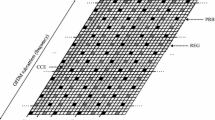Abstract
One of the main advances of 3G networks like UMTS is the ability to support a large variety of different services. These services are subdivided in two domains, circuit-switched services and packet-switched services. The main application expected for packet-switched services is the browsing of the World Wide Web. The web traffic is usually described by quite sophisticated source traffic models and the packet arrivals on IP layer are determined by TCP. On the other hand, the planning process for UMTS networks relies on analytic methods or Monte Carlo simulations that assume the number of users to be Poisson distributed. The intention of this work is to examine if it is possible to apply the existing planning methods to web traffic. We are able to show that the Poisson assumption holds for the number of web users that simultaneously transmit over the air interface and that the resulting NodeB transmit power distribution is valid. We use the Monte Carlo simulation technique to evaluate the web capacity of an example UMTS network.
Preview
Unable to display preview. Download preview PDF.
Similar content being viewed by others
References
3GPP: Quality of service (QoS) concept and architecture. Technical Report TS 23.107 (2004)
3GPP: Radio frequency (RF) system scenarios. Technical Report TR 25.942 (2004)
3GPP: Physical layer procedures (FDD). Technical Report TR 25.214 (2004)
Choi, W., Kim, J.: Forward-link capacity of a DS/CDMA system with mixed multirate sources. IEEE Trans. on Veh. Tech. 50, 737–749 (2001)
Choi, H., Limb, J.: A behavioral model of web traffic. In: Protocol 1999 (ICNP 1999), International Conference of Networking (1999)
Evans, J., Everitt, D.: On the teletraffic capacity of CDMA cellular networks. IEEE Trans. on Veh. Tech. 48, 153–165 (1999)
Leibnitz, K.: Analytical Modeling of Power Control and its Impact on WCDMA Capacity and Planning. PhD thesis, University of Würzburg (2003)
Mäder, A., Staehle, D.: Uplink blocking probabilities in heterogeneous WCDMA networks considering other-cell interference. In: Southern African Telecommunication Networks & Applications Conference, South Western Cape, South Africa (2004)
Schröder, B., Weller, A.: Prediction of the connection stability of UMTS-services in the downlink - an analytical approach. In: Proc. of IEEE VTC Fall, Vancouver, CA (2002)
Staehle, D., Leibnitz, K., Heck, K.: Fast prediction of the coverage area in UMTS networks. In: Proc. of IEEE Globecom, Taipei, Taiwan (2002)
Staehle, D., Mäder, A.: An analytic model for deriving the Node-B transmit power in heterogeneous UMTS networks. In: IEEE VTC Spring, Milano, Italy (2004)
Staehle, D., Leibnitz, K., Tran-Gia, P.: Source traffic modeling of wireless applications. Technical report, University of Würzburg (2000)
Stevens, W.R.: TCP/IP illustrated: The protocols, vol. 1. Addison-Wesley Longman Publishing Co., Inc., Amsterdam (1993)
Stevens, W.R., Wright, G.R.: TCP/IP illustrated: The implementation, vol. 2. Addison-Wesley Longman Publishing Co., Inc., Amsterdam (1995)
Tran-Gia, P., Staehle, D., Leibnitz, K.: Source traffic modeling of wireless applications. International Journal of Electronics and Communications (AEÜ) 55 (2001)
Viterbi, A., Viterbi, A.: Erlang capacity of a power controlled CDMA system. IEEE Journal on Selected Areas in Comm. 11, 892–900 (1993)
Author information
Authors and Affiliations
Editor information
Editors and Affiliations
Rights and permissions
Copyright information
© 2005 Springer-Verlag Berlin Heidelberg
About this paper
Cite this paper
Hoßfeld, T., Staehle, D. (2005). A Hybrid Model of the UMTS Downlink Capacity with WWW Traffic on Dedicated Channels. In: Kotsis, G., Spaniol, O. (eds) Wireless Systems and Mobility in Next Generation Internet. EuroNGI 2004. Lecture Notes in Computer Science, vol 3427. Springer, Berlin, Heidelberg. https://doi.org/10.1007/978-3-540-31963-4_3
Download citation
DOI: https://doi.org/10.1007/978-3-540-31963-4_3
Publisher Name: Springer, Berlin, Heidelberg
Print ISBN: 978-3-540-25329-7
Online ISBN: 978-3-540-31963-4
eBook Packages: Computer ScienceComputer Science (R0)




